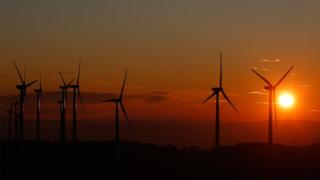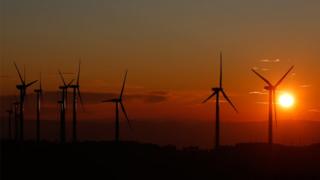Climate change: Worst emissions scenario ‘misleading’
Scientists should stop using the very worst predictions for carbon emissions, a study suggests. …

 Image copyright Getty Images
Image copyright Getty Images The worst-case scenario for emissions of CO2 this century is no longer plausible, say researchers.
Referred to as “business as usual”, the scenario assumes a 500% increase in the use of coal, which is now considered unlikely.
Climate models suggest that this level of carbon could see warming of up to 6C by 2100, with severe impacts.
Researchers say that on current trends, a rise in temperatures of around 3C is far more likely.
How has this confusion come about?
About 10 years ago, ahead of the fifth assessment report from the Intergovernmental Panel on Climate Change (IPCC), researchers developed four different scenarios to describe how carbon emissions might change over the rest of this century.
One of these clumsily titled “Representative Concentration Pathways” (RCPs), was called RCP8.5 and it was intended to show the impact of very high emissions consistent with a five fold increase in the use of coal and virtually no policies to limit CO2 emissions.
RCP 8.5 was first developed by energy researchers to help with their modelling. According to the authors of this paper, they didn’t do a good job of communicating the limitations of this approach to climate scientists who wanted to use it to see what would happen with temperatures.
Rather than being seen as something that only had a 3% chance of becoming reality, it became known as the “business-as-usual” scenario, by climate scientists and has been used in more than 2,000 research papers since.
“What we’re arguing is that we’ve been misusing the worst climate change scenario,” said author Zeke Hausfather, director of the Breakthrough Institute in California.
“Obviously, a lot has changed since 2005 or so when the scenario was created. A lot of clean technology prices have fallen, by factors of five, while global coal use peaked in 2013. And it’s been flat since then.”
“So what originally was a sort of worst-case (scenario) with less than 10% chance of happening is today, exceedingly unlikely.”
Does this mean that climate scientists have been exaggerating the threat?
This is more about scientific assumptions added to a communications cock-up.
Very few scientists realised that RCP8.5 was originally a 90th percentile outcome, not a most likely or business-as-usual outcome. They assumed too much, when they should perhaps have checked, say the authors of the review.
“At the end of the day, scientists have to take responsibility for what they choose as input data, and there should be a degree of due diligence,” said Glen Peter, from the CICERO Center for International Climate Research in Norway.
“How many of your average climate scientists know the nuances of RCP8.5? It would certainly be interesting to know.”
The media, taking their steer from scientists, have tended to use the highest impacts when reporting on projections based on emissions scenarios.
“That’s not to say that these highest-end impacts are impossible to happen, but it is not business-as-usual. And that’s the point we’re really trying to make in this piece.”
Does this mean that our projections about future temperature rises are wrong?
Not necessarily.
This new work questions the chances of very high future emissions because renewable energy is now much cheaper, and competing with coal.
So rather than a world that warms by 6C, it should mean that the world will warm by around 3C based on current policies that countries have signed up to.
However, the authors are at pains to point out that the lower temperatures aren’t guaranteed.
That’s because scientists are still uncertain as to how sensitive temperatures are to CO2. New models are being used for the next set of major projections due from the IPCC next year. Those models are said to show that temperatures are more sensitive to CO2 than previously thought.
There is also the question of climate feedbacks. Although emissions from human activities might level off over this century, warming could see more permafrost melt which will push more methane and CO2 into the air, putting upward pressure on temperatures.
“I don’t think we can rule out a world of four degrees or above, because of these uncertainties in climate sensitivity and the uncertainties in carbon cycle feedbacks,” said Zeke Hausfather.
“So even under a lower emission scenario, you could have higher sea level rise, higher warming impacts, if climate sensitivity ends up being on the high end.”
“If you think of climate as a problem of risk management, you don’t necessarily just want to plan for the most likely outcome, You want to plan for sort of the tail risk, the relatively low probability but high impact scenario.”
What does a world that warms by 3C look like?
The authors point out that a 3C rise would be a global average and that many parts of the world such as the Arctic would likely warm by much more than that.
“You having a world where the coral reefs are largely wiped out at three degrees warming, you’re having a world where combined with deforestation, there’s a real high risk of the Amazon rainforest turning into more of a savannah type ecosystem in the long run,” said Zeke Hausfather.
Experts believe that at 3C, the Arctic sea-ice would be mostly gone in the summer with devastating consequences. It could cause large scale melting of permafrost, It could destabilise roads and houses in the far north and there’s increasing damage to crop yields.
“There’s a lot of real impacts with three degrees that we can’t sweep away. And there’s a non-trivial risk that climate sensitivity is four degrees instead of three.”
Does this review mean human extinction is less likely from climate change?
Many people have concerns that if strong action isn’t taken to curb emissions, then the cumulative effect of all the impacts of climate change could threaten the future of humanity.
“There’s never been that much evidence that climate change is going to literally cause the extinction of the human race,” said Zeke Hausfather.
“But there’s a lot of things in the world that are less bad than literal extinction that we want to avoid at all costs.”
Is this good news in some ways?
Yes – it shows that even the limited attempts to cut carbon that the world has adopted to date are having an impact and the worst emissions scenarios are no longer realistic.
While a world that warms by 3C is a disaster, the progress that’s been made should encourage people to aim for higher targets to try to keep the world to 1.5C of warming, which science suggests is a much safer threshold.
“In many ways this is a success story. It’s not where we want to get it’s not meeting the Paris agreement targets of limiting warming to below 2C, but the world has taken some action and clean energy has gotten cheaper,” said Zeke Hausfather.
“And as that happens, we’re necessarily going to move away from some of the worst case possible outcomes. The more climate policies countries enact, the more we’re going to sort of head toward a world of two to three degrees warming, hopefully on the two side, and hopefully below two, but that requires a lot more political effort.”
The commentary has been published in the journal Nature.
Follow Matt on Twitter.


